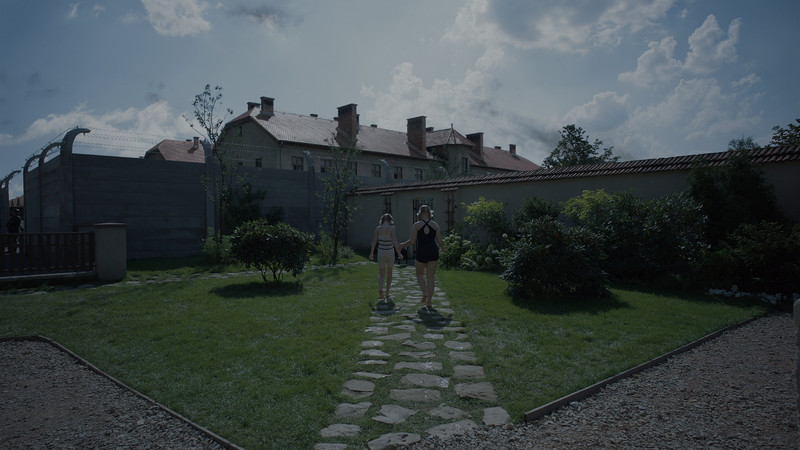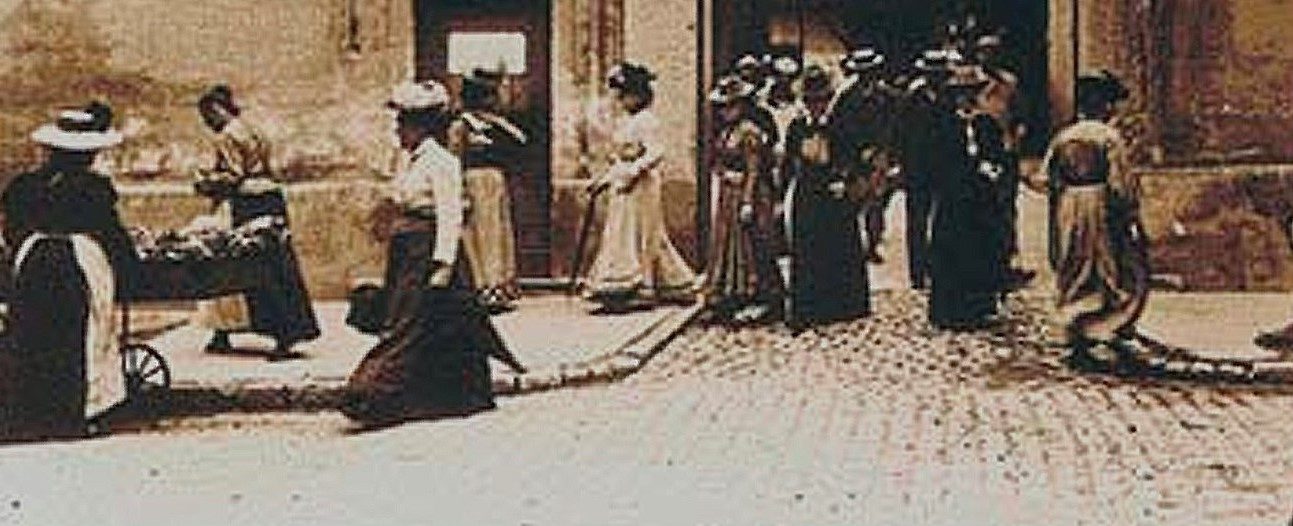United Kingdom, Poland, 2023
Directed by Jonathan Glazer
With Sandra Hüller (Hedwig Höss), Christian Friedel (Rudolf Höss)

While the screen remains dark, the plangent humming sound quietly, slowly lets the chirping of a bird out, and then gives way to the delightful and pure noise of a lively wildlife. The screen, at long last, displays images nicely fitting with those fresh sounds, a sunny day near a river enjoyed by carefree people. As the soundtrack shifted to another register, so images of a perfect day of ordinary happiness has replaced the oppressive dark screen that was so puzzling and portentous. Sound, this astonishing beginning implies, matters more than sight to enter the world the film is ushering in and to grasp what is to happen – sound reveals and determines shifts and tensions, manipulating the audience’s expectation.
The film is over a long first part built over the distance between sight and sound on the one hand and two registers of sounds on the other hand, creating tension. Once the family basking in the sun and having fun on that fair afternoon in that nice countryside goes home, the camera carefully and consciously records the routine of their life in their house, which is rather big, quite modern, with all the amenities that could be wished for, a magnificent garden, plus a bevy of handmaids. But there is a big wall only partly hiding what looks like an industrial complex from where a constant drone wafts relentlessly over the house: the place looks idyllic but it is not that quiet, after all. To this key note, which is not really deafening though if pitched higher it would well be like that, other sounds, far briefer, sharper, creepier, are added from time to time, a more complex tapestry of sounds that shrouds the house like a menace and yet barely disturbs the people inside. Against the queasy background they keep speaking, clamoring, whispering, clanging, shuffling as any ordinary folks in the tritest life. The sounds of the Höss family are not drowned by the sounds of the world next door, they are not altered, they simply keep resonating their own way, grown unconcerned by to those other sounds, part of the wider background as much as those distant chimneys, trees, riverbanks.
But this is no ordinary background. Costumes, props, settings, even more crucially dialogues point out fast enough it is the Polish-based, Nazi-run concentration camp of Auschwitz during World War II. The family’s head, Rudolf Höss, is the camp’s top commandant, widely respected by officers eager to wish him the best on his birthday, which occurs the day after that gay countryside trip and so diligent in his work and eager to deliver the best results that on this very day in his sweet home he accepts to talk with industrialists selling a new design of gas chamber for a far more effective management of the technicalities related to the resolution of the Jewish question (that is, making the racist mass murder he runs a faster, bigger operation). A good father for his five children who likes his lifestyle, Rudolf Höss must spend most of his time at work, just behind the wall: so the house the camera endlessly explores and the family life it thoughtfully dissects look like the exclusive realm of his wife Hedwig Höss. As a consequence she stands often front and center, even more when her mother visits her and when she throws out a party for the kids of other Nazi families.
The tension for the audience, the trouble they must grasp with, the growing malaise inflicted on them on purpose by the specific interplay between sounds and images, lie on the clash between the distant yet real presence of a horrific endeavor of racist mass murder partly managed by a family head and the routine of this family that is so precisely and clinically chronicled by a sophisticated camerawork. What is on screen is made upsetting by what is kept off screen, though it is still perceptible. In case how agonizing this disconnection is was not clearly felt, the narrative offers an embarrassing reminder: the mother’s visit ends up abruptly in an annoying note for Hedwig Höss. Her mother leaves in a rush and stealthily, with not a word uttered, just leaving a short letter on a piece of furniture. Just before the daughter realizes in the early morning, warned by her maids, her mother has fled, the editing has lingered on the face of the mother looking during the previous night through the window of her bedroom at the smoke and fire of the concentration camp’s chimneys with real unease: it is thus strongly suggested that despite what she displayed the old and nice lady has struggled to put up with that disturbing proximity between the home of her daughter and the horror that the state both are loyal to carries out for the sake of their nation’s purity.
But this is just a matter of montage: what the mother writes to her daughter, which ought to clarify and bring in more elements, is left untold, though Hedwig Höss’s peevish attitudes suggest how unpleasant the letter is. But no more would be said about it.
This is another background the film keeps from shooting. A few lines, especially as Hedwig and Rudolf bitterly quarrel after he reluctantly broke the news he was transferred to another job in another region, but other remarks too dropped during her mother’s visit, suggest what the couple’s trajectory has been. In fact these are lives that have been on historical record for a long time, as Rudolf Höss did exist, managed the Auschwitz camp, and even wrote memoirs before being tried and sentenced to death. This is a tale of people finding in the National Socialist Party a worldview fitting their own ideas, and confidently adhering to a popular party that was a carefully organized and tightly-knit community and later a de facto state superimposing its will on the official institutions, offering them the opportunity of having a career, with perks and simply a genuine pride for their personal achievement and the success of their convictions. That means to Hedwig they never had it so good: why move from a place that delivers so much rewards? At any rate, she will not, clinging fiercely to the bourgeois lifestyle, symbolized by the smug moment when she tries a fur coat in her bedroom, at the risk of offending conventions and hurting her husband.
But the film, even as it zeroes in on the vanity and tranquility of Hedwig, does not try to delve deeper inside the characters and their history. It prods the audience into taking note but it does not provoke them with an articulated narrative and elaborate emotions. It is like the cursory chronicle it gives on the concentration camp system next door: everything is summed up cryptically and the audience is supposed to feel appalled and challenged simply through the clever contrast between sounds and sights, the horror and the quiet, proud banality next door. But it may not enough to flaunt the flaws of Hedwig against the backdrop of those dreadful sounds to grasp what is at stake in both a conscience taking part in a crime and this crime itself.
The film, perhaps aware that more is to be showed and told on the Jewish question as defined by the Nazi regime, chooses at one point to put aside the nice house and the unpalatable housewife and to follow Rudolf in conferences and meetings held in Berlin. Oddly, the camera starts to pick up more dazzling and dramatic angles to convey probably the daunting, stately, bureaucratic nature of the regime and its criminal activity. It is barely more illuminating while the narrative takes yet another path: going to Berlin means also paying a visit to doctors. Even as Rudolf is welcomed and recognized as a great SS leader, death may be beckoning – rot can still touch a man so obsessed with cleansing his nation, home, person from the dirt he chose to hate.
At this point the editing veers off the tracks the film has been so ponderously moving along: it jumps forward many decades later, observing, reportage-like, how cleaning ladies take care of the museum that has been created in the Auschwitz concentration camp. If Rudolf is doomed to die fast, the memory of the crime he helped to carry out remains strong and alive. The lesson is conspicuous, but it is indeed the memory that shows what happened: the film has just touched upon the horror only to acknowledge how ordinary feelings and routine can thrive along the awareness of committing a genocide in the minds of a couple, playing first intriguingly then in a far duller mode with what can be off-screen or on-screen but then changing course repeatedly while delivering few insight on what those minds think and feel.
Complicating the assessment are those weird scenes in black and white, a kind of tinkered shots taken by thermal infrared camera, which jar with the elegant color cinematography of “The Zone of Interest”. The first springs when Rudolf reads a fairy tale to his daughter: it seems these new images could illustrate the tale, but then look as a warped version of it. Later they become a narrative of their own, a sort of grim and puzzling fantasy that ends up merging with the wider realistic and colored film. The characters involved in this dream-like development remain murky. The audience is left to their own device to find a connection and a meaning. It is possibly the representation of an act of resistance, a futile attempt to give relief to the prisoners, but then more questions spring to mind. How credible is it? Why this need to deal about a suffering the film has at the same time avoided to picture? Why this urge to suggest hope when the film has painted the bleak picture of a system that is never under fire and in danger? This adds more confusion to an ethical probe which gets mired in the stylistic and intellectual, installation-like, system designed by director Jonathan Glazer. As much as more conventional films (like “Schindler’s List” in 1993), “The Zone of Interest” somehow flounders to represent and inquire in a satisfactory and perceptive manner the horrific scope and singularity of the Nazi regime and genocide.

